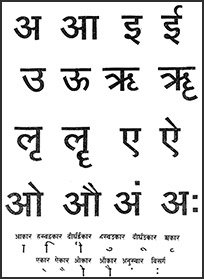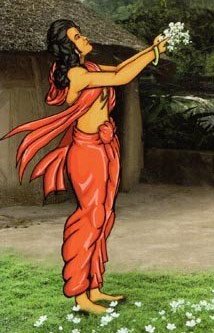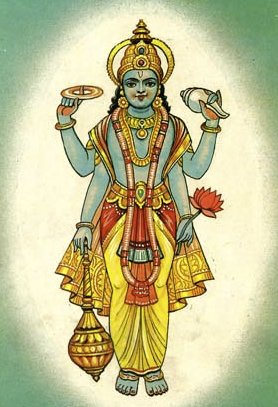Makaranda, Mākaranda, Makaramda: 20 definitions
Introduction:
Makaranda means something in Hinduism, Sanskrit, Buddhism, Pali, Marathi, biology. If you want to know the exact meaning, history, etymology or English translation of this term then check out the descriptions on this page. Add your comment or reference to a book if you want to contribute to this summary article.
In Hinduism
Vyakarana (Sanskrit grammar)
Source: Wikisource: A dictionary of Sanskrit grammar1) Makaranda (मकरन्द).—Name of a commentary by Raṅganātha on the Padamañjari of Haradatta;
2) Makaranda.—Name of a commentary on the Supadma Vyākaraṇa by Viṣṇumiśra.

Vyakarana (व्याकरण, vyākaraṇa) refers to Sanskrit grammar and represents one of the six additional sciences (vedanga) to be studied along with the Vedas. Vyakarana concerns itself with the rules of Sanskrit grammar and linguistic analysis in order to establish the correct context of words and sentences.
Kavya (poetry)
Source: Wisdom Library: KathāsaritsāgaraMakaranda (मकरन्द) is the daughter of a garden in Ujjayinī, according to the Kathāsaritsāgara, chapter 121. Accordingly, as Mahendrāditya asked his messenger Anaṅgadeva: “... and one day I went with my beloved to a garden in Ujjayinī called Makaranda to amuse myself. There it happened that in the dawn a low hypocritical scoundrel of a kāpālika saw me, when I had just woke up from a sleep brought on by the fatigue of roaming about”.
The Kathāsaritsāgara (‘ocean of streams of story’), mentioning Makaranda, is a famous Sanskrit epic story revolving around prince Naravāhanadatta and his quest to become the emperor of the vidyādharas (celestial beings). The work is said to have been an adaptation of Guṇāḍhya’s Bṛhatkathā consisting of 100,000 verses, which in turn is part of a larger work containing 700,000 verses.

Kavya (काव्य, kavya) refers to Sanskrit poetry, a popular ancient Indian tradition of literature. There have been many Sanskrit poets over the ages, hailing from ancient India and beyond. This topic includes mahakavya, or ‘epic poetry’ and natya, or ‘dramatic poetry’.
Ayurveda (science of life)
Nighantu (Synonyms and Characteristics of Drugs and technical terms)
Source: Wisdom Library: Raj NighantuMakaranda (मकरन्द) refers to “flower juice” or “honey”, as mentioned in a list of four synonyms, according to the second chapter (dharaṇyādi-varga) of the 13th-century Raj Nighantu or Rājanighaṇṭu (an Ayurvedic encyclopedia). The Dharaṇyādi-varga covers the lands, soil, mountains, jungles and vegetation’s relations between trees [viz., Makaranda] and plants and substances, with their various kinds.

Āyurveda (आयुर्वेद, ayurveda) is a branch of Indian science dealing with medicine, herbalism, taxology, anatomy, surgery, alchemy and related topics. Traditional practice of Āyurveda in ancient India dates back to at least the first millenium BC. Literature is commonly written in Sanskrit using various poetic metres.
Vaishnavism (Vaishava dharma)
Source: Brill: Śaivism and the Tantric Traditions (vaishnavism)Makaranda (मकरन्द) refers to “nectar”, according to the Vedānta Deśika’s Yatirājasaptati.—There are allusions to Rāmānuja’s “protection” of the Vedas, his defeat of those who hold other Vedāntic views as well as the significance of his establishment of the right interpretation of the Vedas in innumerable verses of the Yatirājasaptati. [...] Verse 31 captures in a lovely set of images the nature of Rāmānuja’s works.They are wish-fulfilling trees for the imagination of debaters, oozing with the nectar (makaranda) of Hari’s feet, possessing many branches so that they can remove suffering/heat, and subduing (with their perfume) the stench of sins.

Vaishnava (वैष्णव, vaiṣṇava) or vaishnavism (vaiṣṇavism) represents a tradition of Hinduism worshipping Vishnu as the supreme Lord. Similar to the Shaktism and Shaivism traditions, Vaishnavism also developed as an individual movement, famous for its exposition of the dashavatara (‘ten avatars of Vishnu’).
Biology (plants and animals)
Source: Google Books: CRC World Dictionary (Regional names)Makaranda in India is the name of a plant defined with Jasminum multiflorum in various botanical sources. This page contains potential references in Ayurveda, modern medicine, and other folk traditions or local practices It has the synonym Nyctanthes pubescens Retz. (among others).
Example references for further research on medicinal uses or toxicity (see latin names for full list):
· Bijdr. Fl. Ned. Ind. (1826)
· Species Plantarum. (1798)
· Encyclopédie Méthodique, Botaniqu (1797)
· Gard. Chron. (1881)
· Blumea (1950)
· Genera Plantarum (1789)
If you are looking for specific details regarding Makaranda, for example chemical composition, diet and recipes, extract dosage, pregnancy safety, health benefits, side effects, have a look at these references.

This sections includes definitions from the five kingdoms of living things: Animals, Plants, Fungi, Protists and Monera. It will include both the official binomial nomenclature (scientific names usually in Latin) as well as regional spellings and variants.
Languages of India and abroad
Pali-English dictionary
Source: BuddhaSasana: Concise Pali-English Dictionarymakaranda : (m.) the nectar of a flower.
Source: Sutta: The Pali Text Society's Pali-English DictionaryMakaranda, (cp. Class. Sk. makaranda) the nectar of a flower J. VI, 530. (Page 511)

Pali is the language of the Tipiṭaka, which is the sacred canon of Theravāda Buddhism and contains much of the Buddha’s speech. Closeley related to Sanskrit, both languages are used interchangeably between religions.
Marathi-English dictionary
Source: DDSA: The Molesworth Marathi and English Dictionarymakaranda (मकरंद).—m S The nectar or honey of a flower. Ex. aṅgīcā akhila ma0 apāra ||.
Source: DDSA: The Aryabhusan school dictionary, Marathi-Englishmakaranda (मकरंद).—m The nectar or honey of a flower.
Marathi is an Indo-European language having over 70 million native speakers people in (predominantly) Maharashtra India. Marathi, like many other Indo-Aryan languages, evolved from early forms of Prakrit, which itself is a subset of Sanskrit, one of the most ancient languages of the world.
Sanskrit dictionary
Source: DDSA: The practical Sanskrit-English dictionaryMakaranda (मकरन्द).—[makaramapi dyati kāmajanakatvāt do-avakhanḍane ka pṛṣo° mum Tv.]
1) The honey of flowers, flower-juice; निषिद्धै- रप्येभिर्लुलितमकरन्दो मधुकरैः (niṣiddhai- rapyebhirlulitamakarando madhukaraiḥ) Ve.1.1; मकरन्दतुन्दिलानामरविन्दाना- मयं महामान्यः (makarandatundilānāmaravindānā- mayaṃ mahāmānyaḥ) Bv.1.6,8.
2) A kind of jasmine.
3) The cuckoo.
4) A bee.
5) A kind of fragrant mango tree.
6) (In music) A kind of measure.
-ndam A filament.
Derivable forms: makarandaḥ (मकरन्दः).
--- OR ---
Mākaranda (माकरन्द).—a. (-ndī f.) Derived from, relating to, the juice of flowers; full of or mixed with honey; प्रचलित इव सान्द्रो माकरन्दः परागः (pracalita iva sāndro mākarandaḥ parāgaḥ) Mālatīmādhava (Bombay) 8.1 (v. l.); 9.13.
Source: Cologne Digital Sanskrit Dictionaries: Shabda-Sagara Sanskrit-English DictionaryMakaranda (मकरन्द).—m.
(-ndaḥ) 1. The nectar or honey of a flower. 2. The Kokila or Indian cuckoo. 3. A bee. 4. A fragrant kind of mango. 5. A kind of jasmine, (Jasminum pubescens.) 6. The filament of a lotus. E. makara the emblem of Kama, and do to destroy, i. e. to surpass, as an incentive to love, aff. ka, form irr.
--- OR ---
Mākaranda (माकरन्द).—f. (-ndī) Relating to the juice of flowers.
Source: Cologne Digital Sanskrit Dictionaries: Benfey Sanskrit-English DictionaryMakaranda (मकरन्द).—I. m. 1. The nectar of a flower, [Prabodhacandrodaya, (ed. Brockhaus.)] 79, 16. 2. A kind of jasmine. Ii. m. The filament of a lotus.
--- OR ---
Mākaranda (माकरन्द).—i. e. makaranda + a, adj. Consisting of the nectar of flowers, [Uttara Rāmacarita, 2. ed. Calc., 1862.] 154, 6.
Source: Cologne Digital Sanskrit Dictionaries: Cappeller Sanskrit-English DictionaryMakaranda (मकरन्द).—[masculine] the juice of flowers, a man’s name; [neuter] = seq.
--- OR ---
Mākaranda (माकरन्द).—[adjective] coming from the juice of flowers.
Source: Cologne Digital Sanskrit Dictionaries: Aufrecht Catalogus Catalogorum1) Makaranda (मकरन्द) as mentioned in Aufrecht’s Catalogus Catalogorum:—See Advaitamakaranda, Nyāyakusumāñjaliprakāśamakaranda, Nyāyamakaranda, Siddhāntamakaranda.
2) Makaranda (मकरन्द):—jy. Pheh. 9. 11. Rādh. 35. See Horāmakaranda.
3) Makaranda (मकरन्द):—Padārthakhaṇḍanavyākhyāṭīkā by Rucidatta. Oudh. Iv, 15.
4) Makaranda (मकरन्द):—poet. [Sūktikarṇāmṛta by Śrīdharadāsa]
5) Makaranda (मकरन्द):—Tithyādipattra, astronomical tables. Io. 2476.
—[commentary] by Kṛṣṇaśarman. Io. 520. 2303.
—[commentary] by Divākara, son of Nṛsiṃha. Fl. 295. 296. Io. 2476. Oudh. Xx, 110. Stein 168.
—[commentary] by Puruṣottama. Peters. 4, 36.
—[commentary] Makarandodāharaṇa by Viśvanātha, son of Divākara. B. 4, 170. Bick. 314. Io. 1681. 2476. K. 236. [Mackenzie Collection] 123. Np. 146. Oudh. Xiii, 64. Xiv, 50. Xx, 110. Peters. 2, 194.
6) Makaranda (मकरन्द):—Tithyādipattra jy. C. As p. 135. C. by Divākara. Peters. 5, 496. C. Abhinavatāmarasā by Puruṣottama. L.. 982. C. Makarandodāharaṇa by Viśvanātha, son of Divākara. As p. 135. Bd. 843. L.. 983.
Source: Cologne Digital Sanskrit Dictionaries: Monier-Williams Sanskrit-English Dictionary1) Makaranda (मकरन्द):—m. the juice of flowers, honey, [Kāvya literature; Purāṇa] etc.
2) a species of jasmine, [cf. Lexicographers, esp. such as amarasiṃha, halāyudha, hemacandra, etc.]
3) a fragrant species of mango, [cf. Lexicographers, esp. such as amarasiṃha, halāyudha, hemacandra, etc.]
4) a bee, [cf. Lexicographers, esp. such as amarasiṃha, halāyudha, hemacandra, etc.]
5) the Indian cuckoo, [cf. Lexicographers, esp. such as amarasiṃha, halāyudha, hemacandra, etc.]
6) (in music) a kind of measure, [Saṃgīta-sārasaṃgraha]
7) Name of a man, [Mālatīmādhava]
8) of various authors and works.
9) n. a filament ([especially] of the lotus-flower), [cf. Lexicographers, esp. such as amarasiṃha, halāyudha, hemacandra, etc.]
10) Name of a pleasure-garden, [Kathāsaritsāgara]
11) Mākaranda (माकरन्द):—mf(ī)n. ([from] makaranda) coming from or consisting of the juice of flowers, [Uttararāma-carita; Mālatīmādhava]
Source: Cologne Digital Sanskrit Dictionaries: Yates Sanskrit-English DictionaryMakaranda (मकरन्द):—[makara-nda] (ndaḥ) 1. m. The nectar or honey of a flower; a cuckoo; a bee; a fragrant mango; a jasmin, filament of a lotus.
Source: DDSA: Paia-sadda-mahannavo; a comprehensive Prakrit Hindi dictionary (S)Makaranda (मकरन्द) in the Sanskrit language is related to the Prakrit words: Bhayaraṃda, Mayaraṃda.
[Sanskrit to German]
Sanskrit, also spelled संस्कृतम् (saṃskṛtam), is an ancient language of India commonly seen as the grandmother of the Indo-European language family (even English!). Closely allied with Prakrit and Pali, Sanskrit is more exhaustive in both grammar and terms and has the most extensive collection of literature in the world, greatly surpassing its sister-languages Greek and Latin.
Kannada-English dictionary
Source: Alar: Kannada-English corpusMakaraṃda (ಮಕರಂದ):—
1) [noun] the saccharine secretion of a plant, which attracts the insects or birds that pollinate the flower; nectar.
2) [noun] a variety in time-cycle in music, that has two groups of variable units followed by two groups of two units each.
Kannada is a Dravidian language (as opposed to the Indo-European language family) mainly spoken in the southwestern region of India.
See also (Relevant definitions)
Partial matches: Makara.
Starts with (+6): Makaranda sharman, Makaranda-mara, Makarandadipika, Makarandaka, Makarandakanay, Makarandakanaya, Makarandakarika, Makarandam, Makarandapaddhati, Makarandapala, Makarandapancangavidhi, Makarandaprakasha, Makarandasaha, Makarandasarani, Makarandasarini, Makarandasharman, Makarandastava, Makarandastotra, Makarandavant, Makarandavasa.
Ends with: Advaitamakaranda, Horamakaranda, Jyotishamakaranda, Kusumanjalimakaranda, Kusumanjaliprakashamakaranda, Lulitamakaranda, Mimamsamakaranda, Nyayamakaranda, Samgitamakaranda, Sangita-makaranda, Shahimakaranda, Shuddhimakaranda, Siddhantamakaranda, Supadmamakaranda, Vivekamakaranda.
Full-text (+54): Maranda, Makarandavati, Makarandika, Makarandam, Makaramda, Makarandavivarana, Makarandavat, Makarandaprakasha, Makarandakarika, Makarandasharman, Makarandapancangavidhi, Makarandadipika, Makarandavivriti, Nyayamakarandavivriti, Nyayamakarandavivecini, Nyayamakarandavivardhini, Acushayati, Makarandakanaya, Makarandapala, Makarand.
Relevant text
Search found 28 books and stories containing Makaranda, Makara-nda, Makaramda, Makaraṃda, Mākaranda; (plurals include: Makarandas, ndas, Makaramdas, Makaraṃdas, Mākarandas). You can also click to the full overview containing English textual excerpts. Below are direct links for the most relevant articles:
Malatimadhava (study) (by Jintu Moni Dutta)
Part 2g - Act-wise Summary of the Mālatīmādhava < [Chapter 1 - Introduction]
Part 2c - The Plot of the Mālatīmādhava < [Chapter 1 - Introduction]
Part 2 - A Note on the Mālatīmādhava < [Chapter 1 - Introduction]
Bhakti-rasamrta-sindhu (by Śrīla Rūpa Gosvāmī)
Verse 4.8.71 < [Part 8 - Compatible & Incompatible Mellows (maitrī-vaira-sthiti)]
Verse 3.5.17 < [Part 5 - Conjugal Love (mādhurya-rasa)]
Verse 3.1.23 < [Part 1 - Neutral Love of God (śānta-rasa)]
A History of Indian Philosophy Volume 2 (by Surendranath Dasgupta)
Part 14 - Ānandabodha Yati < [Chapter XI - The Śaṅkara School of Vedānta (continued)]
Part 21 - Dialectic of Śaṅkara and Ānandajñāna < [Chapter XI - The Śaṅkara School of Vedānta (continued)]
Part 4 - Teachers and Pupils in Vedānta < [Chapter XI - The Śaṅkara School of Vedānta (continued)]
Garga Samhita (English) (by Danavir Goswami)
Verse 4.19.54 < [Chapter 19 - A Thousand Names of Srī Yamunā]
Verse 1.11.12 < [Chapter 11 - Description of Śrī Kṛṣṇacandra’s Birth]
Verse 4.12.11 < [Chapter 12 - The Story of the Gopīs That In the Holi Festival Displayed Three Transcendental Virtues]
Hari-bhakti-kalpa-latikā (by Sarasvati Thkura)
Puranic encyclopaedia (by Vettam Mani)
Related products
